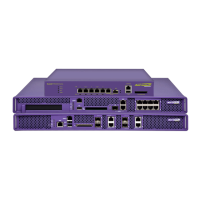Controller Services
Summit WM3000 Series Controller System Reference Guide240
6 Click the Edit button to modify the properties displayed on an existing DHCP pool. For more
information, see “Editing the Properties of an Existing DHCP Pool” on page 240.
7 To delete an existing DHCP pool from the list of those available, highlight the pool from within the
Network Pool field and click the Delete button.
8 Click the Add button to create a new DHCP pool. For more information, see “Adding a New DHCP
Pool” on page 241.
9 Click the Options button to associate values to options, as defined using the Options Setup
functionality. The values associated to options are local to the pool with which they are associated
For more information, see “Configuring DHCP Global Options” on page 243.
10 Click the DDNS button to configure a DDNS domain and server address used with the list of
available pools. For more information, see “Configuring DHCP Server DDNS Values” on page 244.
11 Click the Options Setup button to define the option name, code and type. Associate values to them
(by clicking the Options button) only after the options are defined.
12 Click Apply to save changes to the screen. Navigating away from the screen without clicking Apply
results in all changes to the screen being lost.
13 Click the Revert button to display the last saved configuration. Unapplied changes are not saved and
must be re-entered.
Editing the Properties of an Existing DHCP Pool
The properties of an existing pool can be modified to suit the changing needs of your network.
To modify the properties of an existing pool:
1 Select Services > DHCP Server from the main menu tree.
2 Select an existing pool from those displayed (within the Network Pool field) and click the Edit
button.
3 Modify the name of the IP pool from which IP addresses can be issued to client requests on this
interface.
4 Modify the Domain name as appropriate for the interface using the pool.
5 Modify the NetBios Node used with this particular pool. The NetBios Node could have one of the
following types:
Network
Displays the network address for the clients.
Lease Time
(dd:hh:mm)
When a DHCP server allocates an address for a DHCP client, the client is
assigned a lease (which expires after a designated interval defined by the
administrator). The lease time is the time an IP address is reserved for
re-connection after its last use. Using very short leases, DHCP can
dynamically reconfigure networks in which there are more computers than
there are available IP addresses. This is useful, for example, in education
and customer environments where MU users change frequently. Use
longer leases if there are fewer users.
Domain
Displays the domain name for the current interface.

